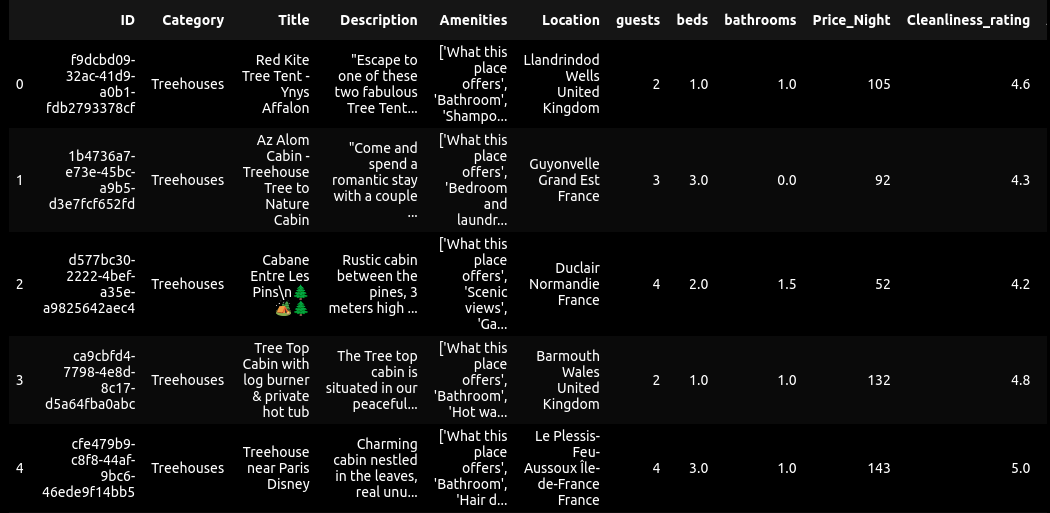Modelling Airbnb's property listing dataset
- General Info
- Technologies Used
- Features
- Screenshots
- Setup
- Usage
- Project Status
- Room for Improvement
- Acknowledgements
- Contact
- Build a framework that systematically train, tune, and evaluate models on several tasks that are tackled by the Airbnb team
joblib==1.2.0 matplotlib==3.6.2 numpy==1.23.4 opencv_python==4.6.0.66 pandas==1.5.1 requests==2.25.1 scikit_learn==1.1.3
-The tabular dataset has the following columns: ID: Unique identifier for the listing Category: The category of the listing Title: The title of the listing Description: The description of the listing Amenities: The available amenities of the listing Location: The location of the listing guests: The number of guests that can be accommodated in the listing beds: The number of available beds in the listing bathrooms: The number of bathrooms in the listing Price_Night: The price per night of the listing Cleanliness_rate: The cleanliness rating of the listing Accuracy_rate: How accurate the description of the listing is, as reported by previous guests Location_rate: The rating of the location of the listing Check-in_rate: The rating of check-in process given by the host Value_rate: The rating of value given by the host amenities_count: The number of amenities in the listing url: The URL of the listing bedrooms: The number of bedrooms in the listing
- Cleaning process of tabular data: remove columns with missing values modify Description column by turning it into a string for "guests", "beds", "bathrooms", and "bedrooms" columns empty entries are replaced with 1.
- Preparation of image data: all images are downloaded and processed through usage of ID column of the matching tabular data all images are resized, the height of the smallest image is set as the height for all of the other images. w by h ratio is preserved resized images are saved into the new data/processed_images location
- Model Training to predict the price for the listing per night - Regression: Use sklearn to compute the key measures of performance forthe model: RMSE, and R^2. Create a function which performs a grid search over a reasonable range of hyperparameter values manually, followed by CVGrideSearch Use decision trees, random forests, and gradient boosting regression models to determine the best model after the CVGrid Search based on R2 scores
- Model Training to predict the Cateogry label - Classification: Use sklearn to compute the key measures of performance for your classification model: F1, recall, precision, validation accuracy. Update tunning function to include classification model tuning with CVGrideSearch Use decision trees, random forests, and gradient boosting classification models to determine the best model after the CVGrid Search best on validation accuracy scores.
All dependancies are listed in the requirements.txt
The hyperparamteters_grids.py contains 8 dictionary grids: 4 for regressionmodels and 4 for classification models
#Hyperparameteres grids
sgd_param = {'alpha': [1e-5, 1e-4, 1e-3, 1e-2, 1e-1, 1, 10, 100],
'learning_rate': ['constant', 'optimal', 'invscaling', 'adaptive'],
'loss': ['squared_error', 'huber', 'epsilon_insensitive','squared_epsilon_insensitive'],
'penalty' : ['l2', 'l1', 'elasticnet'],
'max_iter' : [750, 1000, 1250, 1500]}
decision_tree_param={"splitter":["best","random"],
"max_depth" : [1,3,5,7,9,11,12],
"min_samples_leaf":[1,2,3,4,5,6,7,8,9,10],
"min_weight_fraction_leaf":[0.1,0.2,0.3,0.4,0.5],
"max_features":[1.0, "log2","sqrt",None],
"max_leaf_nodes":[None,10,20,30,40,50,60,70,80,90]}
gradient_boosting_class_param={
"loss":["deviance"],
"learning_rate": [0.01, 0.025, 0.05, 0.075, 0.1, 0.15, 0.2],
"min_samples_split": np.linspace(0.1, 0.5, 12),
"min_samples_leaf": np.linspace(0.1, 0.5, 12),
"max_depth":[3,5,8],
"max_features":["log2","sqrt"],
"criterion": ["friedman_mse", "mae"],
"subsample":[0.5, 0.618, 0.8, 0.85, 0.9, 0.95, 1.0],
"n_estimators":[10]
Project is: in progress
- Done: train regression models with tuning hyperparamters
- Done: train classification models with tuning hyperparameters
- To Do: Nural Network
- This project was inspired by AiCore program.
Created by @irinakw - feel free to contact me!

